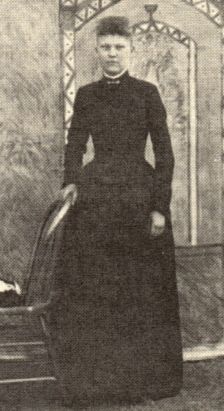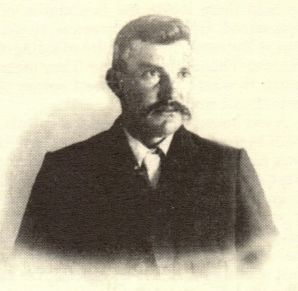CRAWFORD, ALBERT AND HILMA (ANDERSON)
by Alvo Crawford
Entry F100 from the History of Hooker County Nebraska
with permission of the Hooker County Historical Society

Hilma Christine (Anderson) Crawford, about 17 years old.

Albert C. Crawford
Albert Crawford was born June 17, 1868 at
Winterset, Iowa to parents James and Mary
Crawford. His boyhood in Iowa was not the
most pleasant due to the destitution caused
by the Civil War of only a few years before,
and the money panic of 1873, a bare existence
was about all that could be hoped for.
In 1883 the family moved to Boone County,
Nebraska, near the Cedar River. Life was
much better here: There was plenty of food
to eat and meat always was available. By
trapping and earning some money, Albert
was able to have his first gun - a muzzle-
loading shotgun, he was in his glory for he
loved to hunt.
He came with his father in the fall of 1887
to look for free land in the Seneca-Mullen
area that some friends, the LeLaCheurs, who
had lived neighbors to them in Boone
County, were recommending. At this time
Albert was not old enough to take a home-
stead. His father, Jim, found land 2 miles
north of Kelso siding in Thomas County
Territory, which later became Hooker
County, March 29, 1889, and filed on it as a
tree claim. He also filed on 160 acre home-
stead 4 miles east of there, along the Thomas
County line. About 2 years later, Albert filed
on land adjoining in Hooker County. After
the Kinkaid Act of 1904, he filed on land
adjoining it in Thomas County. Though the
land was free, the price was still high: living
with the gnats, and later fleas, was nearly
unbearable. On hot, still days the gnats were
so thick, they could hardly breathe without
inhaling them and they fed freely on people's
ears and back of their neck. Soon the fleas
came and were everywhere where there was
grass and they were always hungry. They
later left the grass and were found in
buildings and corrals.
Albert liked to hunt and made good use of
the muzzle-loading shotgun here in the hills.
He soon made enough money by hunting
prairie chickens to market and buy a new
shotgun and get a bird dog. The market
hunting season lasted about 6 weeks each
year and he would average about 30 to 35
birds a day. The entrails had to be drawn and
cavity filled with green grass right after being
shot. No water was used, it would cause them
to spoil. Each day they would need to be
taken to Seneca, where they were frozen and
packed in barrels and shipped to eastern
markets, at 20 to 25 cents a bird and
sometimes 35 cents, it was REAL money at
that time.
Albert and Jim started at Mercantile Store
in Seneca in 1893, with one or the other going
from the farm each day. They operated the
store until about 1908.
Al, as he was being called, married Hilma
Anderson November, 1899 at the Anderson
family home east of Seneca. Hilma became a
school teacher soon after she and her folks
came to the Sandhills from Illinois, in April
1888. She taught school in Dill Valley; Merz
school near Swan Lake; Norway and in
Seneca before their marriage. Their children
were: Anna (Babe), Bud, Ore who died when
he was 2 years old, and Alvo. The family lived
in town though Al did commute to the
country to do the farming and care for the
livestock.
Beside the store, Al started a meat market
close by, only to have it burn in 1910 in a fire
that started in the livery barn and burned
four businesses in all. After the fire he bought
the Pool Hall that he operated for 2 years
until he found some very nice corn growing
on a place near his farm that could be bought
for $10 an acre. He had always been a farmer
at heart, so he sold the Pool Hall and bought
the farm, never to return to business in town
again.
During his years in business he was a
"locator" as they were called, one who is a
surveyor and could show settlers their exact
land. He traveled with a team and wagon for
miles around. His price was $5 a day unless
they camped out under the stars overnight,
when it was $10. He also surveyed several
roads in Thomas and Cherry Counties. The
last surveying he did was up near Pony Lake
in Cherry County in 1942. He was elected
Thomas County Surveyor for years.
During WWII a group formed a flying club,
bought a training plane and established an
airport at Al's place. Since there was no
airport between North Platte and Valentine
at that time there was quite a little activity.
It is unique that the first automobile Al
ever saw, drove into his yard in 1909; the first
radio he listened to, was in his own home; the
first airplane he saw in the air, was from
home; his first airplane ride was from his own
place. Al lived to see his land farmed for 64
years. He was the first to grow alfalfa in
Thomas County. He and Hilma lived on the
homestead the rest of their lives. Hilma
passed away in 1944, Al in 1952. Hilma liked
to raise a garden and did much canning of it,
fruit, meat, etc. She liked to raise chickens
and turkeys. She particularly enjoyed Project
Club with neighboring friends. Al and Hilma
endured many privations, as did all the
pioneers carving out a niche in our great
Sandhills, leaving it to us much better than
they found it.
Return

